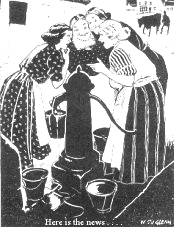 Here is the news ... Cartoon. Dublin Opinion. |
 HEAT WAVE IN BALLYSCUNNION 'Come back later, Sean. I'm having a bath.' Cartoon. Dublin Opinion. |
Most 'duties in the home' during this period were carried out by women working without the aid of modern appliances. People in Ireland were slow to use gas and electricity compared with people in the USA and the rest of Europe.
| By the 1920s no house was considered modern or properly equipped unless it had electric light, but it was only in the mid twenties that the public was beginning to realise the advantages of using electricity for cooking, heating, washing, ironing and vacuum cleaning. In the years before the Shannon scheme was inaugurated, Ireland had by far the lowest consumption of electricity of any modern European country - 16 units per head of population. In 1923 there was a consumption of 26 units per head in Dublin as against 105 in Amsterdam. There were 40,000 houses in Dublin city and 13,000, less than one-third, had electricity installed. Only 23% of people in Cork and 9% in Limerick had electricity. Mona Hearn, Below stairs: domestic service remembered, Dublin, 1993, p. 109. |
Electricity and gas were available only in cities and larger towns for several years and they were used mainly for lighting. Gradually people bought labour-saving devices and most households in towns had electricity by 1947.Now the ESB began its Rural Electrification Scheme which would bring electricity to rural homes by the mid 1950s.
The Irish Housewives Association (IHA) was founded as a pressure group in 1942 during the 'Emergency' to ensure better food, health and general conditions in the home.
The Irish Countrywomen's Association (ICA), founded as the 'United Irishwomen' in 1910 had over 6,000 members in 1948. They campaigned vigorously to secure the supply of piped water for rural homes. In 1946, 90% of rural households still depended on water from wells, streams or pumps or were collecting rainwater while 90% of town households had piped water.
At this time, the ICA co-operated with the Department of Local Government to organise an imaginative Turn on the tap exhibition which toured Ireland promoting the advantages of piped water. Group water schemes were subsequently set up in many areas, though 42% of rural homes still lacked piped water in 1971.
| Most vocal opposition (to rural water schemes) came, somewhat ironically, from the National Farmers' Association (NFA), who objected that the government's scheme would result in farmers being forced to pay higher rates on agricultural land and on farm buildings. Mary E. Daly,'Turn on the tap' in Maryann G. Valiulis and Mary O' Dowd , Women & Irish History, Dublin, 1997, p. 216 |
 Here is the news ... Cartoon. Dublin Opinion. |
 HEAT WAVE IN BALLYSCUNNION 'Come back later, Sean. I'm having a bath.' Cartoon. Dublin Opinion. |
The vast majority of family homes were held by husbands in their sole names but a husband was under no legal obligation to provide for his wife in his will. The result was that many widows found themselves penniless and even homeless on the deaths of their husbands. By the Succession Act, 1965, a widowed spouse was entitled to the family home and one half of the estate if there were no children, otherwise one third of the estate.
Widespread awareness of several other important factors affecting the lives of women would have to wait until the 1970s for the Report of the First Commission on the Status of Women (1972) and the Irish Women's Liberation Movement.